Cultural Sustainable Development Strategies of Chinese Traditional Furniture: Taking Ming-Style Furniture for Example
Abstract
:1. Introduction
2. Materials and Methods
2.1. Aesthetic Characteristics of Traditional Furniture: Taking Ming-Style Furniture as an Example
2.1.1. Shape and Functional Beauty
2.1.2. Structure and Connection Beauty
2.1.3. Material and Process Beauty
2.1.4. Color and Furnishing Beauty
2.1.5. Decoration and Aesthetic Beauty
2.1.6. Concept and Ecological Beauty
2.2. The Reasons for Prosperity and Decline of Traditional Chinese Furniture Art
2.3. Research “Methodology of Affairs”
3. Cultural Sustainable Development Strategies for Traditional Furniture: Improved Translation of Internal Factors
3.1. Translation of Shape and Function
3.2. Translation of Structure and Connection
3.3. Translation of Material and Process
3.4. Translation of Color and Furnishing
3.5. Translation of Decoration and Aesthetics
4. Cultural Sustainable Development Strategies for Traditional Furniture: Adaptive Changes in External Factors
4.1. Policy Perspective: Furniture and Intangible Cultural Heritage Inheritors, Intellectual Property Protection, Education and Talents
4.2. Economic Perspective: Furniture and Innovation
4.3. Cultural Perspective: Furniture and Cultural Communication Channels
4.4. Social Perspective: Furniture and Social Memory, Immersive Experience
4.5. User Perspective: Furniture and Poetic Life, Elegant Aesthetics
5. Discussion
6. Conclusions
- The essence of the sustainable development of traditional furniture is a process of finding the roots of history and modernizing them. Contemporary new Chinese-style furniture designers can start from the improved translation of the internal factors and the adaptive changes in external factors of traditional furniture, comprehensively analyze the internal translation of the aesthetic characteristics of Ming-style furniture, such as shape, function, structure, material, and decoration, and put this into a modern external environment composed of politics, economy, culture, society, and users in a process of systematic thinking, so as to better serve the innovative design of new Chinese-style furniture.
- Therefore, the purpose of exploring the sustainability strategies of traditional furniture based on the Ming style is not only to protect the continuation of a style, but also the inheritance of a culture and an aesthetic. There is still a long way to go for traditional furniture culture to be recognized and accepted by modern society and to maintain good adaptability and inheritance among society, groups, and individuals. The article provides a new research idea and strategy for this purpose, and also provides inspiration for scholars working in the field of the protection and development of traditional culture.
Author Contributions
Funding
Data Availability Statement
Acknowledgments
Conflicts of Interest
References
- Dai, X.-D. A Comparative Study of Chinese and Japanese Traditional Furniture Culture. Ph.D. Thesis, Central South University of Forestry and Technology, Changsha, China, 2007. [Google Scholar]
- Pei, S.; Gu, Y. Application and research on morphological bionic design of Ming-style literati furniture. Furnit. Inter. Decor. 2020, 11, 31–33. [Google Scholar] [CrossRef]
- Zhao, C.-L.; Zhao, X.-Y.; Yang, B.-Y.-T. A preliminary study on the application of Ming-style furniture elements in modern furniture design. For. Prod. Ind. 2022, 59, 55–59. [Google Scholar] [CrossRef]
- Liu, H.-Z.; Tu, J. Research on the modern application of Ming-style seating elements. Furnit. Inter. Decor. 2021, 6, 1–6. [Google Scholar] [CrossRef]
- Zou, W.-H. Exploration of generative design method for new chinese style furniture. Decoration 2011, 5, 112–113. [Google Scholar] [CrossRef]
- Zou, W.-H.; Li, Z.-M.; Sun, D.-L. The teaching content of Shanghai style furniture design for Chinese art design speciality. Heliyon 2022, 08, e11627. [Google Scholar] [CrossRef]
- Zhu, S. “Artificial science” in the perspective of art and design: Focusing on Herbert Simon’s main response in Chinese design circles. Des. Art (J. Shandong Inst. Arts Crafts) 2008, 1, 15–17. [Google Scholar]
- Yan, Z.-H. Research on the design of new Chinese-style furniture based on the characteristics of Ming-style furniture. Furnit. Inter. Decor. 2022, 29, 81–85. [Google Scholar] [CrossRef]
- Liang, M.-J.; Liu, Y.-S.; Geng, X.-J. Research on the innovative application of traditional Chinese mortise and tenon structure in modern furniture. Furnit. Inter. Decor. 2021, 11, 14–17. [Google Scholar] [CrossRef]
- Yan, Z.-H. Modular analysis of Ming-style chairs and stools furniture. Packag. Eng. 2020, 41, 157–161. [Google Scholar] [CrossRef]
- Chen, J. Design research on the expansion of mortise and tenon elements in the field of modern design. Packag. Eng. 2017, 38, 138–142. [Google Scholar]
- Fan, L.-Y. On the unity of beauty and goodness in Ming-style furniture design. Packag. Eng. 2020, 41, 360–364. [Google Scholar] [CrossRef]
- Jing, N.; Zhou, J.; Liu, Z.-Q. A brief discussion on the color design of Ming-style furniture. Furniture 2017, 38, 51–54. [Google Scholar] [CrossRef]
- Liu, Y. An analysis of the style characteristics of Qing Dynasty furniture. Pop. Lit. Art 2021, 10, 57–58. [Google Scholar]
- Wen, Z.-H. Collation of Superfluous Things, 1st ed.; Jiangsu Science & Technology Press: Nanjing, China, 1984; pp. 372–377. [Google Scholar]
- Niu, X.-T. Ingenious thinking on the end decoration of Ming-style furniture components from the perspective of indicating function. Packag. Eng. 2020, 41, 199–203+227. [Google Scholar] [CrossRef]
- Zhang, D.-Y. Notes on The Records of Examination of Craftsmen, 1st ed.; Shanxi People’s Fine Arts Publishing House: Xian, China, 2004; pp. 142–147. [Google Scholar]
- Liu, Y.-X.; Yuan, J.-D.; Mei, Z.-Y. The influence of the social environment of the Ming Dynasty on the manufacturing behavior of furniture craftsmen from a sociological perspective. Hunan Packag. 2023, 38, 9–12. [Google Scholar] [CrossRef]
- Peng, Y. Research on the impact of Zhu Yuanzhang’s sea ban policy on foreign trade in the Ming Dynasty. Lantai World 2013, 33, 87–88. [Google Scholar] [CrossRef]
- Xu, S.-L.; Fu, K.; Li, K.-Z. Analysis of commonalities between Baroque style furniture and Qing style furniture. Furniture 2002, 43, 101–104. [Google Scholar] [CrossRef]
- Miao, Y.-F.; Lu, Q.-H.; Gu, J.-H.; Zou, F. Research on the Manchu lifestyle and furniture development during the Ming Dynasty. Furnit. Inter. Decor. 2020, 9, 22–24. [Google Scholar]
- Dai, X.-D.; Wang, T.-Q.; Qian, Y.-Q.; Li, Q. An analysis of the discontinuation of Ming and Qing furniture art in modern times. J. Nanjing Univ. Arts (Art Des.) 2021, 2, 49–53+219. [Google Scholar]
- Liu, G.-Z. From “creating things” to “planing things”: The change in the way of thinking in industrial design. J. Suzhou Vocat. Tech. Coll. Arts Crafts 2015, 3, 1–6. [Google Scholar]
- Zhu, Y. Design dilemmas and ideas of contemporary new Chinese-style furniture from the perspective of sustainable development. Furnit. Inter. Decor. 2021, 4, 38–42. [Google Scholar] [CrossRef]
- Niu, X.-T. Looking for the roots of craftsmanship: Analysis and thoughts on the beauty of Ming-style furniture. Art Des. Res. 2022, 3, 81–86. [Google Scholar]
- Xie, H. A study on the influence of Ming-style armchairs on Wagner’s “Chinese Chair” from the perspective of semiotics. Furnit. Inter. Decor. 2021, 5, 44–47. [Google Scholar] [CrossRef]
- Yu, K. Exploration and research on the modern translation of traditional Chinese Ming-style furniture. Packag. Eng. 2020, 41, 150–161. [Google Scholar] [CrossRef]
- Gao, X.-H. The integration of Ming-style armchair furniture in modern home design. J. Jiyuan Vocat. Tech. Coll. 2020, 19, 68–73. [Google Scholar]
- He, J.-R.; Yi, L.-Q.; Huang, K.; Zhang, Z.F.; Zhang, J.J. Design of armchair mortise and tenon structure for digital manufacturing. For. Prod. Ind. 2023, 60, 77–81. [Google Scholar] [CrossRef]
- Xue, K. Research on the Performance and Design Evolution of Traditional Furniture Mortise and Tenon Structures. Ph.D. Thesis, Nanjing Forestry University, Nanjing, China, 2013. [Google Scholar]
- Wu, C.-J.; Song, S.-S.; Liu, Y.; Liu, H.R. Innovative design of bamboo chair furniture based on KANO model and TRIZ theory. J. For. Eng. 2024, 9, 177–183. [Google Scholar] [CrossRef]
- Hu, Q.-W. Research on the design of bamboo laminated material seating based on perceptual imagery. Furnit. Inter. Decor. 2023, 30, 82–89. [Google Scholar] [CrossRef]
- Luo, K.-M.; Xiao, D.-B.; Guo, Q.-Y. Research on innovative design of bamboo woven furniture based on analytic hierarchy process. Furnit. Inter. Decor. 2023, 30, 43–49. [Google Scholar] [CrossRef]
- Du, G.-Y.; Gong, J.-H.; Liu, X.-S. Lightweight design of new Chinese-style chair made of bamboo laminated materials based on finite element method. For. Prod. Ind. 2023, 60, 39–44. [Google Scholar] [CrossRef]
- Chen, Y.; Huang, A.-M.; Meng, S.-R.; Ni, L. Research progress on factors affecting wood deformation and cracking and measures to prevent cracking. World For. Res. 2024, 37, 71–76. [Google Scholar] [CrossRef]
- Wang, J.-H.; Chen, Y.; Zhang, Z.-P.; Hu, J.; Yang, R.L.; Guo, F.; Yu, Y. Research progress on the effect of heat treatment on wood toughness. World For. Res. 2023, 36, 51–57. [Google Scholar] [CrossRef]
- Huang, T.-H.; Wang, J.-F.; Song, L.-H.; Lei, F.J.; Yang, Z.Q. Masson pine wood properties and modification research status. World For. Res. 2023, 36, 45–50. [Google Scholar] [CrossRef]
- Guo, D.-K.; Guo, N.; Fu, F.; Yang, S.; Li, G.Y.; Chu, F.X. Research progress on organic modification to enhance physical and mechanical properties of wood. Mater. Her. 2023, 37, 266–276. [Google Scholar]
- Zhang, M. Study of “source” and “element” in eastern and western ways of creation. J. Nanjing Arts Inst. (Fine Arts Des.) 2018, 4, 166–169. [Google Scholar]
- Wang, Y.-M. Prototype-based furniture morphological semantic design. Design 2018, 5, 110–111. [Google Scholar]
- Wang, X.-G.; Jia, B. Problems and solutions regarding sustainable development of historical and cultural heritage in Central Plain. Henan Soc. Sci. 2008, 16, 33–36. [Google Scholar]
- Fan, K.-K.; Feng, T.-T. Discussion on sustainable development strategies of the traditional handicraft industry based on Su-style furniture in the Ming dynasty. Sustainability 2019, 11, 2008. [Google Scholar] [CrossRef]
- Qian, Y.-Q.; Dai, X.-D. Analysis on the development ideas of new Chinese style furniture. Furnit. Inter. Decor. 2021, 3, 36–39. [Google Scholar] [CrossRef]
- Chen, Z.-J.; Guan, H.-Y. Problems and countermeasures of modern Chinese furniture. J. Fujian Agric. For. Univ. (Philos. Soc. Sci. Ed.) 2008, 5, 104–107. [Google Scholar]
- Xue, G.-L.; Chen, J.-L. Strategies for applying shape grammar to wooden furniture design: Taking traditional Chinese Ming-style recessed-leg table as an example. BioResources 2024, 19, 1707–1727. [Google Scholar] [CrossRef]
- Yu, K. Research on New Ming-style furniture design from the perspective of regional cultural genes. Packag. Eng. 2023, 44, 382–391. [Google Scholar] [CrossRef]
- Su, C.; Zheng, X.-R.; Zheng, J.-Y. Research on furniture design that imitates Chinese characters based on extension semantics and shape grammar. For. Prod. Ind. 2023, 60, 58–65. [Google Scholar] [CrossRef]
- Luo, F.; Dai, X.-D.; Li, W.; Luo, S. Strategies to enhance brand value of new Chinese style furniture. For. Prod. Ind. 2015, 42, 22–25. [Google Scholar] [CrossRef]
- Han, J.-A. Artistic creativity drives corporate branding. Hundreds Artist. 2014, 30, 217–219. [Google Scholar]
- Zhang, W. Wooden furniture design for user experience. For. Prod. Ind. 2014, 41, 43–46. [Google Scholar] [CrossRef]
- Wang, T.-Y.; Ren, H.-Y. The integration of traditional Chinese ecological aesthetics and furniture design and manufacturing. Lit. Artist. Debate 2022, 7, 203–208. [Google Scholar]
- Huang, S.-Y.; Ye, X. The definition of “Chinese” tradition in new Chinese-style furniture. J. Northwest For. Univ. 2013, 28, 192–196. [Google Scholar]
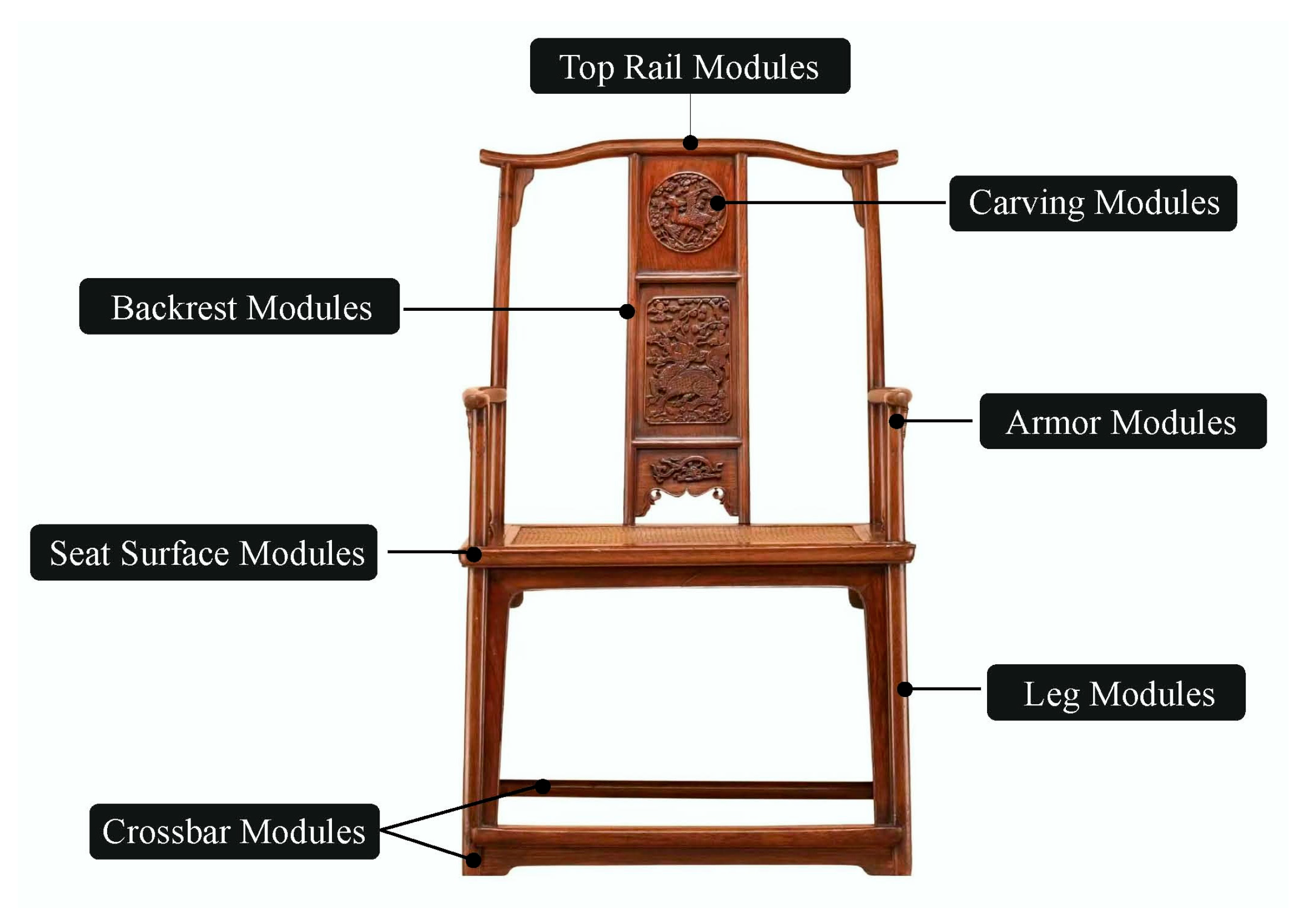
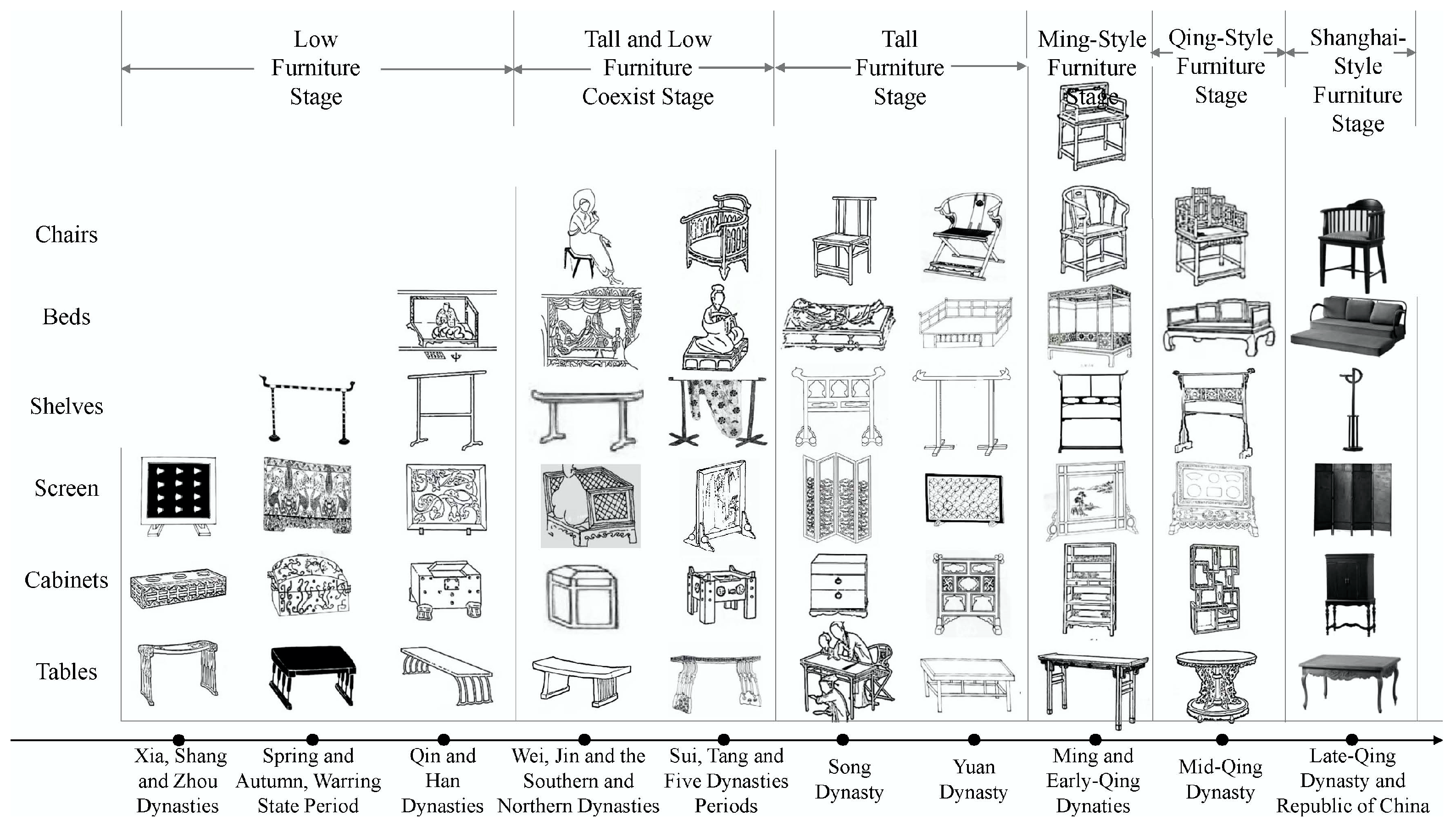



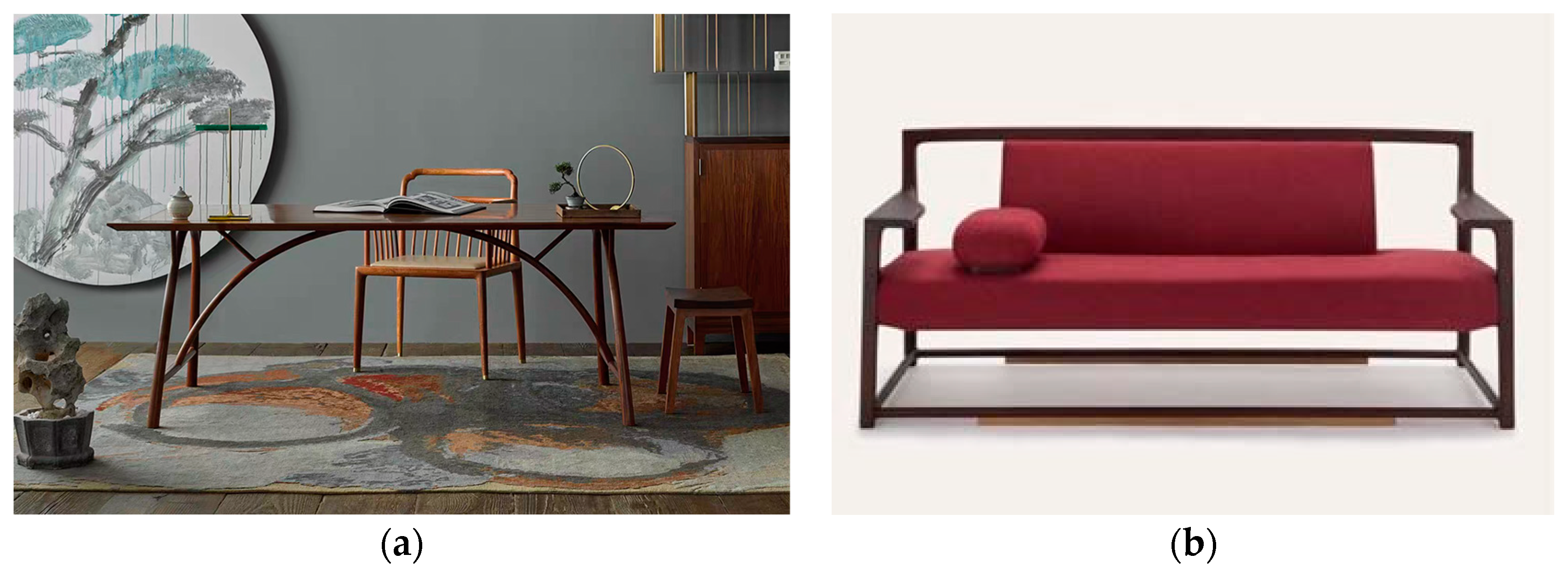
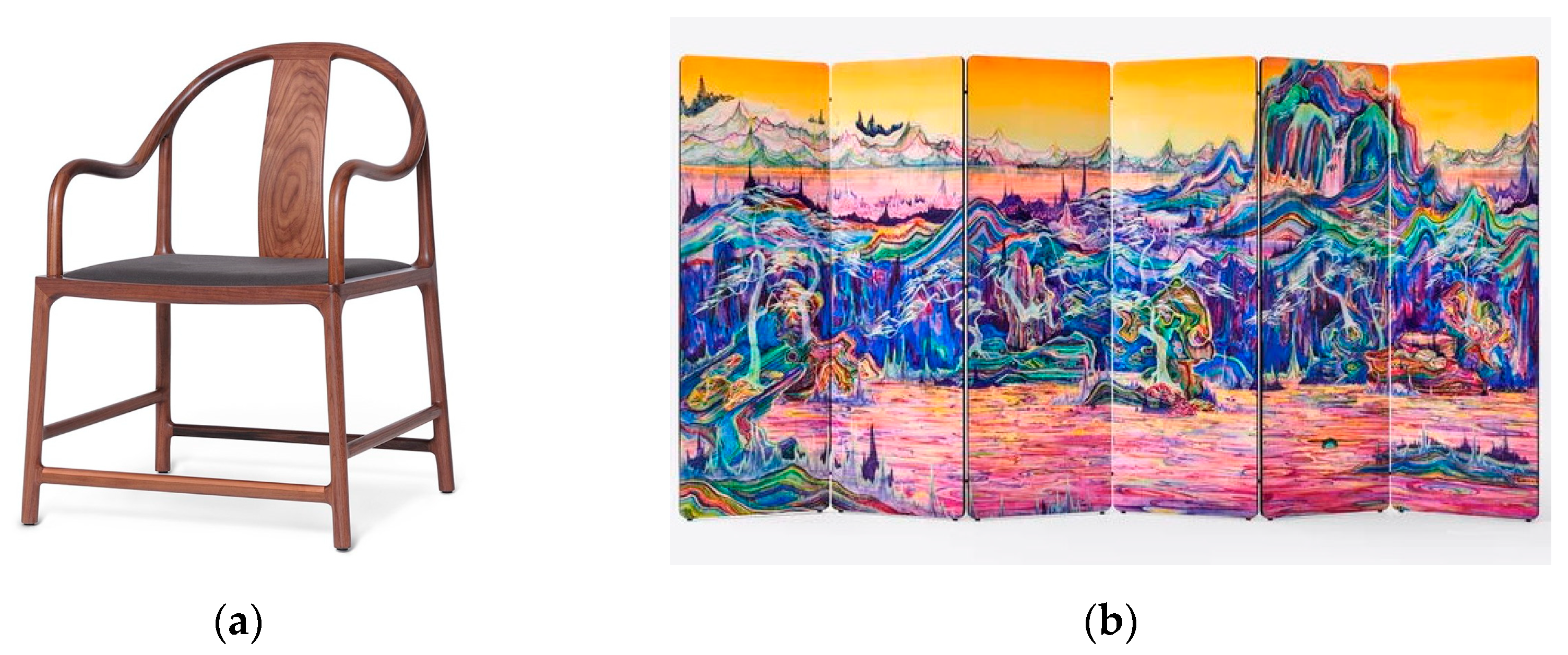
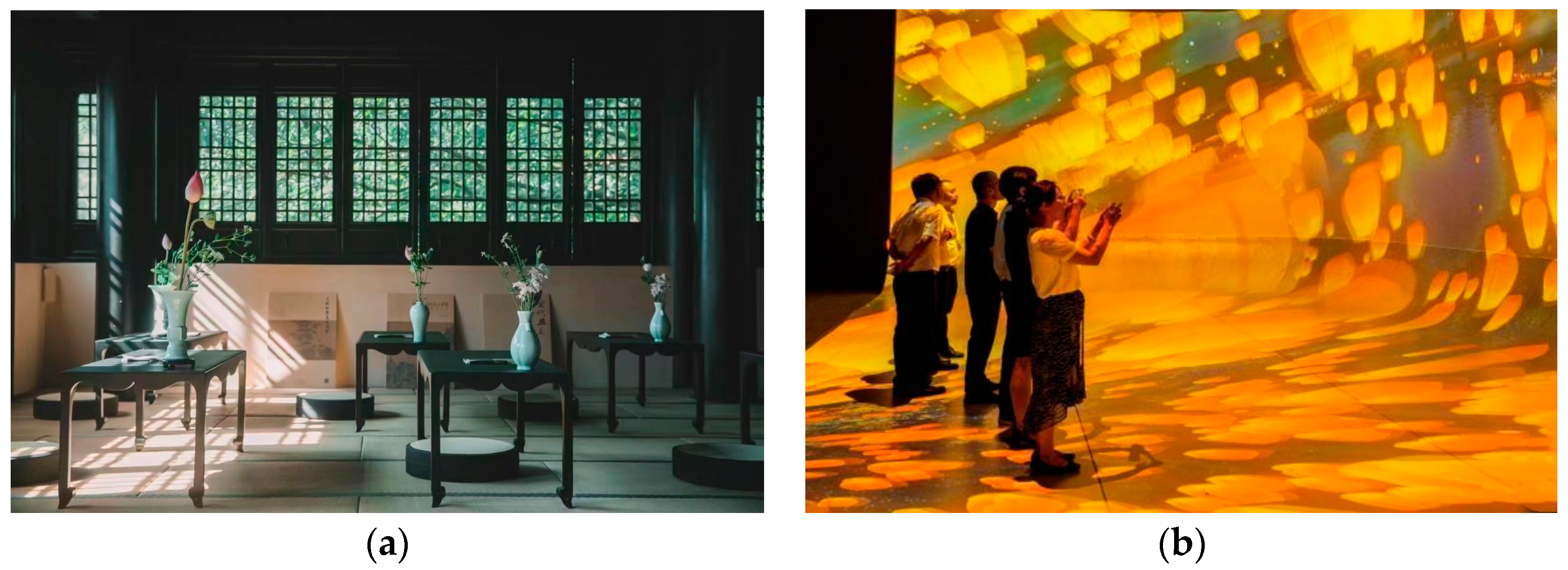
Disclaimer/Publisher’s Note: The statements, opinions and data contained in all publications are solely those of the individual author(s) and contributor(s) and not of MDPI and/or the editor(s). MDPI and/or the editor(s) disclaim responsibility for any injury to people or property resulting from any ideas, methods, instructions or products referred to in the content. |
© 2024 by the authors. Licensee MDPI, Basel, Switzerland. This article is an open access article distributed under the terms and conditions of the Creative Commons Attribution (CC BY) license (https://creativecommons.org/licenses/by/4.0/).
Share and Cite
Xue, G.; Chen, J.; Lin, Z. Cultural Sustainable Development Strategies of Chinese Traditional Furniture: Taking Ming-Style Furniture for Example. Sustainability 2024, 16, 7443. https://doi.org/10.3390/su16177443
Xue G, Chen J, Lin Z. Cultural Sustainable Development Strategies of Chinese Traditional Furniture: Taking Ming-Style Furniture for Example. Sustainability. 2024; 16(17):7443. https://doi.org/10.3390/su16177443
Chicago/Turabian StyleXue, Guanlan, Jinglian Chen, and Zhuozhuang Lin. 2024. "Cultural Sustainable Development Strategies of Chinese Traditional Furniture: Taking Ming-Style Furniture for Example" Sustainability 16, no. 17: 7443. https://doi.org/10.3390/su16177443
APA StyleXue, G., Chen, J., & Lin, Z. (2024). Cultural Sustainable Development Strategies of Chinese Traditional Furniture: Taking Ming-Style Furniture for Example. Sustainability, 16(17), 7443. https://doi.org/10.3390/su16177443





